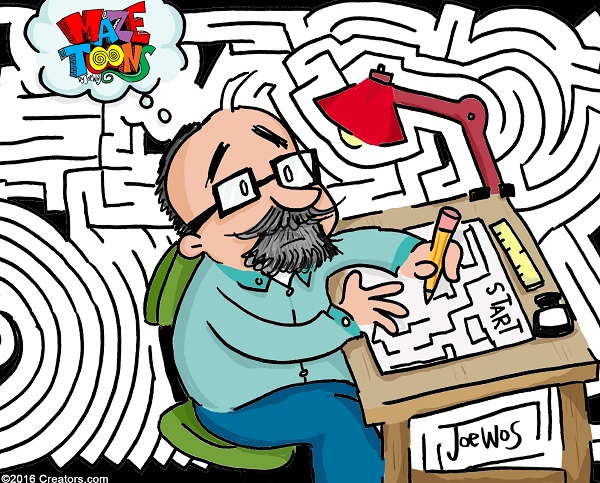
The a-maze-ing tale of Joe Wos
It is a bit unusual to get the job you dreamed about as a kid. Otherwise, we’d be awash in astronauts and zookeepers.
Joe Wos is one of the lucky ones. Like a lot of kids, his favorite thing was drawing mazes and cartoons. Now, he’s a professional maze designer with his “MazeToons” cartoon illustrated mazes appearing as a syndicated feature in newspapers all over the country.
He just published his first complete book of mazes, “A-Maze-Ing Animals: 50 Mazes for Kids” (Barron’s Educational Series $6.99), with a second close behind. Oh, and he holds the record for drawing the world’s biggest hand-drawn maze, which he sold to a shopping mall in China. It measures 4 feet high by 36 feet long.
Or, rather, it was the biggest.
Until other people started to realize that this was a record that could be broken. Wos has plans to take the title back.
“It has 200 different images — totally random,” says Wos. “I’d have people give suggestions, and I’d just put them in there. Kids would say ‘Draw a hippo on a bicycle!’ and I’d do that.”
His a-maze-ing story started exactly the way you’d expect.
“Like every kid in the ‘70s, I loved drawing mazes,” Wos says. “I started working illustrations into them at a very early age. When I was looking to get myself on the funny pages, I didn’t know if I could do a comic strip. This was my way in.”
Wos founded the Toonseum museum of cartoon art, which was first located at the Children’s Museum of Pittsburgh before moving to its permanent space in the Cultural District, Downtown.
Right now, he’s fully dedicated to making mazes and cartoons, telling and writing stories.
His mazes are unique in a few ways, he says.
“I start with a ‘Start!’ Then I’ll build a little maze, work on the images, and connect things as I go,” he explains. “I don’t draw a solution path first. I let it happen organically. I’ll draw a path and split it into two more, then two more. Halfway through, I’ll start drawing from the finish, and treat the finish as if it’s a start.
“I actually don’t know until the end whether it can be solved. I have an idea. I suspect it can…but I don’t know until the end.”
So the usual trick for figuring out mazes (pro tip: start from the ‘End’), doesn’t work on his mazes.
The mazes don’t just go around the cartoony illustrations of goofy animals and their environments. They go in and around and through them.
“I love the rainforest one,” Wos says. “I did a lot of research on it. It’s what I call ‘unintentionally educational.’ Even if you’re too young to solve the mazes, they’re wonderful counting exercises: How many giraffes are hidden in the maze?’ ”
Not many saw the adult coloring book craze coming a few years ago. Wos hopes mazes are the next big thing.
“Mazes are far superior to coloring books as a cognitive exercise,” he says. They are an ancient art form that’s been around for thousands of years.
“Some of the earliest cave paintings are of labyrinths,” he adds. “Mythology is filled with labyrinths and mazes. Churches and mosques often have them on the tile floors as a way to focus prayers.”
Wos’s maze books are available at most bookstores, as well as on Amazon. You can find signed copies at Penguins Books in Sewickley, and the Pitt bookstore. The $6.99 price point was intentionally set low, meant to encourage impulse buys like picking it up for a long plane or car ride.
Mazes are not simply passive entertainment, which is the main draw for Wos.
“I like mazes so much because they’re a truly interactive art form,” he says. “There’s a collaboration between the artist and his audience. The drawing isn’t complete until someone solves it.”
Joe Wos shared a few of his mazes with Kidsburgh. Head to our Activities page to try them out.